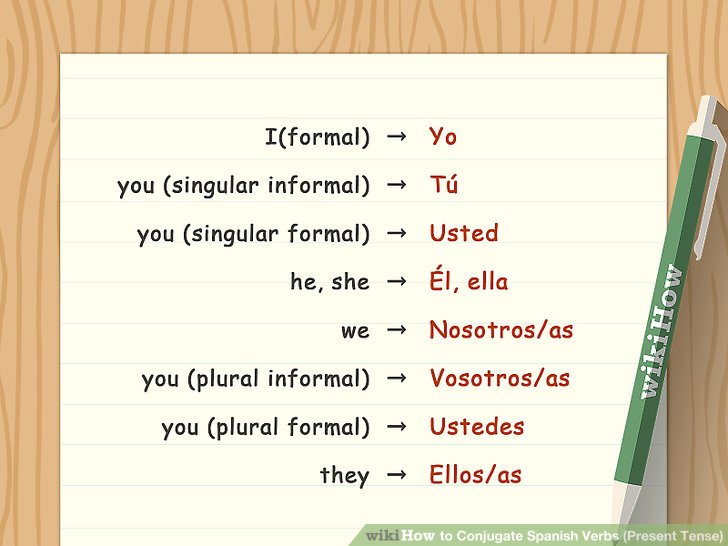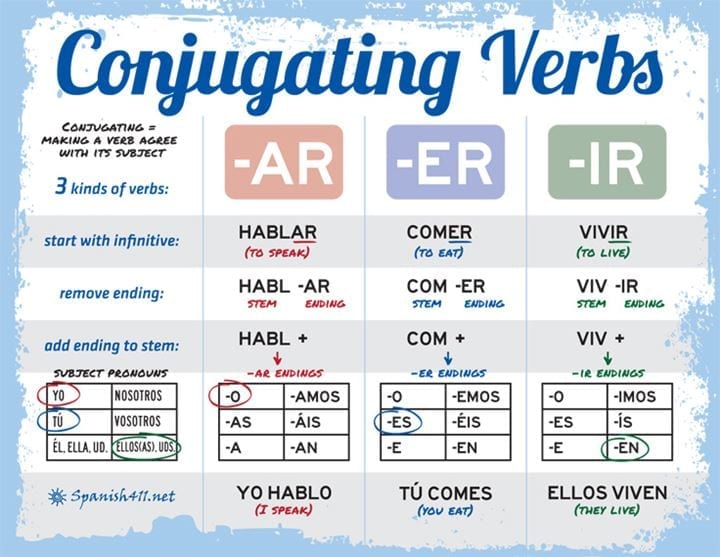Click to see all conjugation charts of hacer in every tense
In this Spanish conjugation lesson we will see how to conjugate the verb hacer in the Presente tense of the Indicativo mood. It means we will see step by step how to create and translate forms of each grammatical person.
This lesson is specifically about the hacer conjugation. For a general overview of Simple Tenses conjugation have a look at our Simple Tenses Conjugation Chart.
We also have a Video Presentation on how to conjugate verbs in Presente. It’s embedded below, but using the above link you can see more detailed information on conjugation in this tense and explanation of special cases and exceptions.
How to translate Presente to English
Notice that the phrases in English provided below next to each conjugation are not direct translations from Spanish to English. They are usually the closest general equivalents. The example differences are:- In Spanish conjugation, there is the form usted in the third person singular. But this person does not translate to the English third person singular. It translates to the so called formal you and uses the inflected form which is most often represented as he/she/it in English conjugation charts.
- Similar situation happens in the third person plural, where ustedes translates to the English plural formal you but uses the form which corresponds to the they form in English.
- Tenses are used differently in Spanish and English, so the actual translation should always take into account the context and focus on translating the meaning, not just words.
- In both languages each verb may have multiple meanings and not every meaning translates directly to the other language. Here also, the context and focusing on the particular meaning helps to create the most accurate translation.
The Spanish Presente de Indicativo tense translates to one of the following:
- The English Present tense, for instance: ustedes hacen(formal, plural) you do
- The English Present Progressive (also called Present Continuous) tense, for instance:ahora mismo tú hacesyou are doing right now
Note that the Spanish equivalent of the Present Progressive also exists and is in common use – that’s Presente Progresivo (or Presente Continuo).
Note the timeline
The ability to correctly locate the desired position on the timeline is a crucial skill for the right use of tenses. So pay attention to the timeline in our lessons and visualize it while listening, speaking, writing and reading. After some practice you will be capable of selecting the right tense to use much easier.
Step by step instructions
Presente belongs to the simple tenses group, which means that all of its conjugated forms are one word long. There are also compound (compuesto) tenses in the Spanish language, where each conjugated form consists of two words.The verb hacer has an almost regular conjugation in the Presente tense of the Indicativo mood. An exception is the first person singular, which has an irregular form. It means the other persons follow the basic rules for this group (-er) without further spelling corrections or exceptions. The basis for this conjugation is the stem of the verb, so we need to start by splitting the infinitive into a stem and an ending. It’s very easy to do. Just remove two letters from the end of the infinitive to get the ending — one of -ar, -er or -ir. What’s left is the stem. So in case of our verb:- the stem is: hac-
- and the ending is: -er
- yo hago – I do
- tú haces – you do
- él hace – he does
- ella hace – she does
- usted hace – (formal) you do
- nosotros hacemos – we do
- nosotras hacemos – (feminine) we do
- vosotros hacéis – (plural) you do
- vosotras hacéis – (feminine, plural) you do
- ellos hacen – they do
- ellas hacen – (feminine) they do
- ustedes hacen – (formal, plural) you do
This is it! The conjugation is now finished. The final result looks as follows:
| yo | hago | I do |
| tú | haces | you do |
| él/ella/usted | hace | he/she/it does |
| nosotros/nosotras | hacemos | we do |
| vosotros/vosotras | hacéis | you do |
| ellos/ellas/ustedes | hacen | they do |
But do not end your session yet – it is very important to repeat and practice the material in order to retain it. Check below for example phrases and suggestions.
Example sentences
Todos los domingos mis amigos y yo hacemos picnic y jugamos en el parque, cantamos, brincamos y lo gozamos mucho!
Every Sunday my friends and I have a picnic and we play in the park, sing, jump and enjoy it a lot!
¿Existe algo que realmente te gusta, te produce satisfacción y te hace sentir muy bien?
Is there something that you really like, that gives you satisfaction and makes you feel great?
Supongo que nadie lo hace aquí.
I guess no one does it here.
No existe nada bueno ni malo, es el pensamiento humano el que lo hace aparecer así.
There is nothing good or bad, it is the human mind that makes it appear so.
Debe ser difícil para ti levantarte cada día, salir y hacer lo que haces.
It must be hard for you to get up every day, go out and do what you do.
Las cosas que haces deben ser las que amas y las cosas que amas deben ser las que haces.
Do what you love and love what you do.
Sí, bueno, tú siempre lo haces todo por mí.
Yeah, well, you always do everything for me.
Lo hago dos veces al día, por la mañana y por la tarde.
I do it twice a day, in the morning and in the evening.
Hoy es el primero de abril y como es tradicional, hacemos chistes.
Today is the first of April and in line with tradition, we make jokes.
¿Qué hago si mis padres no me permiten tener un novio?
What do I do if my parents don't let me have a boyfriend?
Next Steps to Perfection
|
Report a mistake | Give feedback
Thank you very much for making the effort to contact us!
We strive to provide the highest quality content and we greatly appreciate even the smallest suggestions:
We strive to provide the highest quality content and we greatly appreciate even the smallest suggestions:



